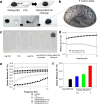Carbon black-containing self-healing adhesive hydrogels for endoscopic tattooing
- PMID: 36732365
- PMCID: PMC9895047
- DOI: 10.1038/s41598-023-28113-1
Carbon black-containing self-healing adhesive hydrogels for endoscopic tattooing
Abstract
Endoscopic tattooing with India ink is a popular method for identifying colonic lesions during minimally invasive surgery because it is highly challenging to localize lesions during laparoscopy. However, there is a perceived unmet need for the injection of India ink and carbon particle suspension due to various complications and inconstant durability during the perioperative period. In this study, carbon black-containing self-healing adhesive alginate/polyvinyl alcohol composite hydrogels were synthesized as endoscopic tattooing inks. Alginate (Alg) conjugated with phenylboronic acid (PBA) groups in the backbone was crosslinked with polyvinyl alcohol (PVA) because of the dynamic bonds between the phenylboronic acid in alginate and the cis-diol groups of PVA. The carbon black-incorporated Alg-PBA/PVA hydrogels exhibited self-healing and re-shapable properties, indicating that improved intraoperative localization could be achieved. In addition, the adhesive tattooing hydrogels were stably immobilized on the target regions in the intraperitoneal spaces. These carbon black-containing self-healing adhesive hydrogels are expected to be useful in various surgical procedures, including endoscopic tattooing.
© 2023. The Author(s).
Conflict of interest statement
The authors declare no competing interests.
Figures







References
Publication types
MeSH terms
Substances
LinkOut - more resources
Full Text Sources
Miscellaneous

